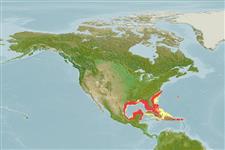Environment: milieu / climate zone / depth range / distribution range
Ecologia
marinhas associadas(os) a recifes; intervalo de profundidade 5 - 820 m (Ref. 13608), usually 5 - 150 m (Ref. 85070). Subtropical; 36°N - 18°N (Ref. 85070)
Western Atlantic: coast of southern USA (18.0°N-36.5°N) and throughout Gulf of Mexico.
Tamanho / Peso / Idade
Maturity: Lm ? range ? - ? cm
Max length : 10.0 cm TL macho/indeterminado; (Ref. 7251)
Descrição suscinta
Chaves de identificação | Morfologia | Morfometria
Espinhos dorsais (total) : 0; Raios dorsais (total) : 4 - 6; Espinhos anais: 0. This species of the H. aculeatus complex is distinguished by having 2 narrow black bands across pectoral fin; with well-developed outer sphenotic tubercle and strongly reduced inner sphenotic tubercle; tubercles relatively small but sharp; tubercles almost always absent dorsal to orbit; relatively fine reticulate pigmentation pattern on dorsal surface (i.e. densely arranged network of melanophores); relatively small with adult body size usually attaining <7.0 cm SL (Ref. 85070).
Inhabits bare sandy bottom where, during the day, it rests partly covered by a thin layer of sand (Ref. 5521).
Ciclo de vida ou comportamento de acasalamento
Maturidade | Reprodução | Desova | Ovos | Fecundidade | Larvas
Ho, H.-C., P. Chakrabarty and J.S. Sparks, 2010. Review of the Halieutichthys aculeatus species complex (Lophiiformes: Ogcocephalidae), with descriptions of two new species. J. Fish Biol. 77(4):841-869. (Ref. 85070)
Status na Lista Vermelha da UICN (Ref. 130435: Version 2024-1)
Ameaça para os humanos
Harmless
Uso pelos humanos
Ferramentas
Relatórios especiais
Baixar XML
Fontes da internet
Estimates based on models
Preferred temperature (Ref.
123201): 21.7 - 27.6, mean 24.9 °C (based on 548 cells).
Índice de diversidade filogenética (Ref.
82804): PD
50 = 0.5625 [Uniqueness, from 0.5 = low to 2.0 = high].
Bayesian length-weight: a=0.02344 (0.00968 - 0.05678), b=2.94 (2.73 - 3.15), in cm total length, based on LWR estimates for this (Sub)family-body shape (Ref.
93245).
Nível Trófico (Ref.
69278): 3.3 ±0.5 se; based on size and trophs of closest relatives
Resiliência (Ref.
120179): médio(a), tempo mínimo de duplicação da população 1,4 - 4,4 anos (Preliminary K or Fecundity.).
Fishing Vulnerability (Ref.
59153): Low vulnerability (10 of 100).
Nutrients (Ref.
124155): Calcium = 49 [21, 146] mg/100g; Iron = 0.685 [0.342, 1.373] mg/100g; Protein = 19.2 [16.6, 22.4] %; Omega3 = 0.254 [0.094, 0.689] g/100g; Selenium = 19.5 [7.3, 49.1] μg/100g; VitaminA = 75.9 [16.2, 361.8] μg/100g; Zinc = 0.902 [0.527, 1.482] mg/100g (wet weight);
